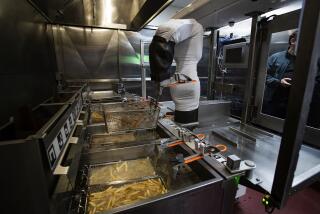Assembly Line Flexibility Sets Japanese Apart
HIROSHIMA, Japan — Masami Ishihara, the man in charge of building what is arguably the hottest car in the Western world, is about to beat a headache that has been bugging him for months.
The kind of headache that his counterparts in Detroit would dearly love to have.
For here in Hiroshima, Ishihara is the boss of Assembly Line No. 5 inside Mazda’s giant U-1 plant, and that means that he is responsible for building Mazda’s Miata two-seat convertible, the automobile that has evoked a kind of visceral lust among millions of Americans.
The public clamoring for the cute little roadster has reached absurd heights--which brings us back to Ishihara’s quandary.
Since the Miata was introduced last spring, Ishihara has been frustrated--he has been able to build only about 20,000 of them, and demand has so far outstripped supply that Mazda’s American dealers have been eagerly gouging their customers with astronomical sticker prices.
Miata production has been severely restricted because the car must share space on its assembly line with Mazda’s 323, 929 and RX7 models, all of which are big sellers.
But now, Ishihara has figured out how to triple Miata production for 1990: He plans to shift production of Mazda’s 323 subcompacts to another nearby line inside the same factory. That should free up more space for the Miata, enabling Mazda to build 60,000 this year--including 40,000 earmarked for the United States.
So, though it has taken a while, Mazda will thus catch up with its customers long before they start to lose interest in the Miata.
“When we get a hot car, we can accommodate demand,” Ishihara said.
And Ishihara has Mazda’s remarkably flexible approach to manufacturing to thank for that.
Not only can Mazda build four, five or even six different cars on the same assembly line, it can also have two or three of those complicated lines running inside the same factory. Without sacrificing quality.
That is unheard of in Detroit, yet it is commonplace in Japan, where the scarcity of available land long ago forced manufacturers to find ways to consolidate their operations. For Japan, that flexibility played a critical role in helping its auto industry retain its competitive edge over America’s Big Three throughout the 1980s.
It has also helped the Japanese adapt more readily to changes in the marketplace--and provided them with a way to produce a wider assortment of new cars much more cheaply than is possible in Detroit. With the ability to plug new models into existing assembly lines, the Japanese can often avoid the prohibitively high costs of building new plants.
Nissan, for instance, created its Infiniti line of luxury cars for only about $500 million--much more cheaply than American observers thought possible. It saved money by building the Infiniti Q-45 at an existing assembly plant in Tochigi, Japan, sharing an assembly line with the Nissan Cedric and Nissan Cima, luxury cars sold only in Japan.
Mitsubishi is following the same course with its new 1991 3000GT, which will be introduced next fall. The sleek, 300-horsepower sports car will be built at Mitsubishi’s assembly plant in Nagoya, which also produces pickup trucks and the company’s Sigma sedan. By thus holding down manufacturing costs, Mitsubishi will be able to offer the 3000GT for just $31,000, far less than comparable European and American sports cars. General Motors, by contrast, has gone in the opposite direction as it has tried to compete with the Japanese. GM has reportedly spent more than $3 billion on its new Saturn car, with much of that money going for a new manufacturing complex in Tennessee that will be dedicated exclusively to Saturn.
Few Big Three plants, in fact, are capable of producing more than one or two different cars on the same line, unless they are nearly identical models hiding behind different nameplates. Ford’s Wixom, Mich., luxury car factory builds just three models--the Lincoln Continental, Lincoln Town Car and the Continental Mark VII--yet it is still the most flexible plant in the domestic industry. It is the only Big Three assembly plant that can build both front-wheel-drive and rear-wheel-drive cars on the same line.
By doing so much mixing and matching on their assembly lines, the Japanese are better able than Detroit to adapt to wild swings in consumer tastes. Unlike the U.S. Big Three, the Japanese do not have to shut down an entire plant just because the sales of one car line tail off, and that helps them live up to their no-layoff guarantees to workers.
“If you build a plant for each model, you have problems when sales go down,” Ishihara said. “Our system is much more cost-efficient.”
By concentrating their production, the Japanese can also get by with far fewer assembly plants than can the U.S. auto makers.
Honda, for example, has just two assembly plants in all of Japan, producing more than 1.3 million cars between them. Honda’s Suzuka plant, the largest in Japan, produces more than 800,000 cars a year on three assembly lines; the plant’s 10,000 workers build nine different models, and both right-hand- and left-hand-drive versions of each.
Toyota, which produces 4 million cars a year in Japan, has just five Japanese assembly plants; GM has 36 North American assembly plants producing 5 million cars and trucks a year. None of GM’s plants produce more than about 250,000 vehicles annually.
To maintain their manufacturing flexibility in the face of a worsening labor shortage in Japan, the Japanese auto companies are starting to make massive new investments in robotics in a nationwide campaign to dramatically increase their use of new forms of automation.
Detroit, which has worked hard throughout the 1980s to keep pace with the Japanese in robotics, seems destined to fall behind once more.
Reinvesting the huge profits from their export boom, the Japanese are equipping some of their plants--including their new ones in the United States--with nearly twice as many robots as are installed in the typical Big Three factory.
For instance, Toyota’s Motomochi assembly plant in Toyota City has 435 robots in just its body shop, where 93% of all sheet metal welding for the Toyota Cressida has been automated. At GM’s huge Lake Orion, Mich., Cadillac factory, by comparison, there are only 163 robots in the entire plant.
“Everybody in Japan is trying to increase their automation,” said Kaname Kasai, general manager of Honda’s Sayama assembly plant, which already has 480 robots. “We are trying to get more automation in areas of our plant where we have had quality inconsistencies in the past.”






